Custom Molded Rubber Grommets
Designing a custom rubber grommet requires understanding the following:
1. Knowing the parts of a grommet
2. Determining the purpose of the grommet:
A. Vibration Control
B. Protecting edges of a thru-hole
C. Dust or weather seal around a wire or tube
1. Knowing the Parts of a Grommet
Catalog shaped grommets often have a simple diagram showing general dimensions. Often these grommets are symetrical around the center of the panel thickness (dimension B in the image here).
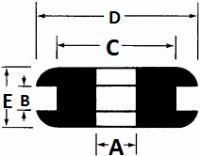
If this type of symmetrical grommet will work for your application, chances are there is a catalog house that can supply what you're looking for. Custom Rubber Corp.'s molded grommets generally have more dimensions than what's shown above - because they are custom, every part of the grommet can be customized and can include infinite variations.
For purposes of designing a custom molded grommet, there are four components of a grommet:
- Head - this is the geometry of the top of the grommet and does not have to be symmetrical to the rest of the grommet.
- Neck - this is the section of the grommet that is often the thickness of the panel or bracket - noted as dimension B in the drawing above.
- Body - this is the geometry of the bottom of the grommet and this also has infinite options.
- ID hole - this is the hole thru the center of the grommet - but again since these are custom grommets, the hole does not have to be the same diameter all the way through; it could be on an angle, and it could be covered with a thin membrane in some cases.
2. Determining the Purpose of the Custom Molded Rubber Grommet
The general concept of a grommet can be applied to a number of different challenges. The inherent features of the shape allow a grommet to be press fit into an application and stay in place without adhesive or any additional fasteners. Custom Rubber Corp. has used grommet-like features in numerous applications and our experience in engineering custom rubber components can assist you with your current challenge.
In general, there are three primary uses for custom rubber grommets:
A. Vibration Control
B. Protecting edges of a thru-hole
C. Dust or weather seal around a wire or tube
Below is a detailed outline of critical items for each of the three uses.
2.A. Custom Rubber Grommets for Vibration Control
Generally grommets used in vibration control will press-fit into a bracket of some kind and a bolt will pass through the ID hole to secure the whole thing to a frame. These are used to isolate vibration on small motors in things like air conditioners, industrial fans, small fans and drive motors in automobiles, and other household appliances.

Pictured here is an example of a vibration control grommet. The grommet separates the metal bracket that holds a drive motor from the base and the rubber material absorbs and dampens the vibration from the drive motor so it doesn't pass through to the base.
In other cases, the custom rubber grommet shape is integrated into a vibration controlling bumper.

Pictured here are small bumper grommets that eliminate vibration translation in an automotive glove box door. The grommet's shape holds the bumper in place without adhesive or other fasteners and the bumper head absorbs the vibration so it doesn't pass through to other components.
For custom molded vibration control grommets, there are a number of options:
2.A.i. Head Design For Vibration Control Grommets
Generally these grommets are pressed into some sort of bracket and the head of the custom grommet can be designed to ease installation - it doesn't have to be as large as the body.
Rounded or Tapered: At the very least, the head of a vibration control grommet should be rounded, tapered, or chamfered around it's OD. This will assist with installation thru the mounting bracket or steel or plastic plate which it's being pressed through.
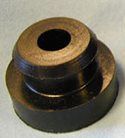 Pull Tab and Taper:
Pull Tab and Taper: In instances where the grommet is a bumper had has no ID thru-hole, a pull tab can be added along with a tapered head - this makes installation very easy and the geometry can be designed so that the grommet is very difficult to remove.

The compilation picture here shows a pull-tab grommet feature on its own and then assembled into a steel plate.
Headless: Perhaps the most innovative head design for a custom vibration control grommet is "headless". This design is the easiest to install. The head has essentially the same OD as the neck which makes it very easy to install. There can be slight ridges on the OD the cause a press fit into the hole in the bracket or the plate of steel - these hold the grommet in place before the bolt is installed in the ID.
The secret of the headless grommet lies in the geometry of the ID where there is a small buldge at a calculated distance from the top of the grommet. When a bolt is installed and tightened, the top of the grommet flexes around the ID bulge and collapses to form the head of the grommet.
Despite the fact that the head of the grommet is made from rubber that is flexed, Custom Rubber Corp. has never heard of a field failure of this design.

2.A.ii. Material Selection for Rubber Molded Vibration Grommets
Selecting the right material for a vibration control grommet is important, and Custom Rubber Corp. can help pick the material that's the most cost effective for your application.
Material Selection Table
| MATERIAL |
ABBREVIATION |
VIBRATION
ISOLATION |
RELATIVE PRICE |
TEMPERATURE RANGE |
OZONE, UV RESISTANCE |
OIL RESISTANCE |
| Natural |
NR |
Excellent |
Good |
-60F to 220F |
Poor |
Poor |
| Butyl |
IIR |
Excellent |
Fair |
-75F to 250F |
Good |
Poor |
| Ethylene-Propylene |
EPDM |
Good |
Excellent |
-70F to 250F |
Excellent |
Poor |
| Nitrile |
NBR |
Good |
Good |
-30F to 250F |
Poor |
Excellent |
| Neoprene / Chloroprene |
CR |
Excellent |
Excellent |
-60F to 220F |
Good |
Fair |
| Silicone |
VMQ |
Good |
Fair |
-175F to 450F |
Excellent |
Fair |
2.A.iii. Body Design For Vibration Control Grommets
The body of a custom vibration control grommet can obviously be anything required.
Flat or Traditional: This is the standard shape for the body of a grommet - a sample is pictured here.
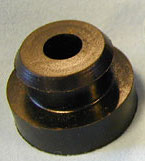
This shape is the most stable base for a vibration control grommet and the most economical from a tool construction standpoint. In many cases, this design will suffice.
Contoured: Another option that improves vibration isolation is to remove some material in order to give the rubber somewhere to flex to. The headless grommet design is the best illustration of this concept. Pictured here is a cross section of the headless grommet - note the moat around the neck of the grommet.
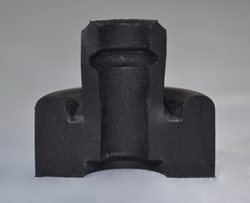
This focuses the pressure of the bracket on the outer diameter of the body and allows more compression and can make an improvement in vibration isolation.
2.B. Custom Rubber Grommets for Protecting Edges of a Thru-Hole
Another common use for rubber molded grommets is to protect cables, wires, and tubes from the sharp edges of a thru-hole in sheet metal or machined hole. For this application, there are three things to consider:
- The flange extension
- The angle of the thru-hole
- Material selection
2.B.i. Flange Extension
With every grommet, care must be taken to ensure that the flange or maximum outer diameter (OD) is large enough to keep the grommet in place. If the head and body of the grommet do not extend far enough beyond the hole in the sheet metal, the grommet will easily become dislodged and can fall out. While there is no rule of thumb, the larger the ID opening is, the farther out the head and body extension has to be. Custom Rubber Corp. can always help with the engineering to determine the optimal flange extension.
Shown here is a custom grommet that is designed to protect a tube passing through a 2" hole in sheet metal.

The maximum OD is 2.75", which in this case is enough to make sure the grommet stays in place after installation.
At the other end of the spectrum is a small grommet designed to protect a 0.50" diameter hole through sheet metal.

In this instance, the maximum OD is only 0.626" - the flange does not have to overhang the edge of the sheet metal hole nearly as far.
2.B.ii. ID Thru-Hole Angle
All standard grommets have an ID hole that is perpendicular to the body of the grommet. The beauty of a custom grommet is the ability to design something special that can assist in keeping things small and compact when necessary. The best example of this is a custom rubber grommet molded by Custom Rubber Corp. that has an angled ID thru-hole.
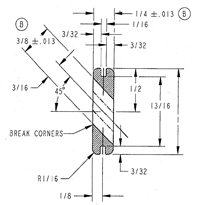
The angled ID allowed the wires to take a more direct route from one side of the sheet metal to the other in this particular application. That reduced the strain on the wires and made assembly easier.
It's important to remember that once you make the decision to move forward with a custom rubber grommet, anything is possible.
2.B.iii. Material Selection for Custom Protection Grommet
Grommets used in this type of application are designed to be static and so material selection can be weiged more heavily towards cost effectivenss. The only exceptions to this is whether or not the hole in the sheet metal will be de-burred (if not then tear resistance becomes important) and any environmental exposure such as heat.
Material Selection Table
| MATERIAL |
ABBREVIATION |
TEAR RESISTANCE |
RELATIVE PRICE |
TEMPERATURE RANGE |
OZONE, UV RESISTANCE |
OIL RESISTANCE |
| Natural |
NR |
Excellent |
Good |
-60F to 220F |
Poor |
Poor |
| Ethylene-Propylene |
EPDM |
Good |
Excellent |
-70F to 250F |
Excellent |
Poor |
| Nitrile |
NBR |
Good |
Good |
-30F to 250F |
Poor |
Excellent |
| Neoprene / Chloroprene |
CR |
Good |
Excellent |
-60F to 220F |
Good |
Fair |
| Silicone |
VMQ |
Fair |
Fair |
-175F to 450F |
Excellent |
Fair |
2.C. Custom Rubber Grommets for Dust or Weather Sealing
Grommets can also be used as a dust barrier for an enclosure when wires or tubes need to pass through the enclosure wall. There are a few different options to think through when looking at this application.
- ID hole membrane or not?
- Slit grommet or not?
- Material selection
2.C.i. ID hole membrane or not?
In order to seal out dust and weather, there are two options for a grommet ID hole. The hole can be designed to fit tightly over the wire or tube that is passing through it which creates a potentially water-tight seal, or the ID hole can be covered with a thin membrane that can be slit to allow the wire to pass through and keep most of the dust, etc. out.

The picture here shows three different options for an ID hole (left to right):
- An open hole - able to handle a wide range of cables or tubes passing through the ID and cost effective to manufacture
- A single slit membrane - flexible in handling different cable and tube sizes and good dust protection; only one slit but when pierced by the cable or tube, it flexes open above and below the cable
- A star-shaped slit membrane - flexible in handling different cable and tube sizes and good dust protection; the multiple slits reduce the distortion of the membrane around the cable or tube
2.C.ii. Slit grommet or not?
This question is related to the first question and the answer is dependent on whether the cable/tube with the end fittings in place, will fit through the ID of the grommet. In some cases, it makes the most sense to slit the through the OD of the grommet so that it can be easily put in place without having to run the entire cable or tube all the way through.
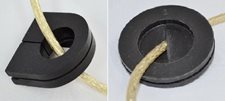
This picture shows the two options;
- The grommet on the left is slit through the flat end which allows the grommet to be applied without having to feed the entire cable or tube through the ID hole. Once in place, the grommet will be pressed together, closing the slit, which provides a good dust barrier.
- The grommet on the right has no slit through the OD and requires the assembler to feed the entire cable or tube through the ID. The advantage of this design is one less path for leaking or dust intrusion, but this design can be more costly to install in the end application.
2.C.iii. Material Selection
Material selection for grommets used as dust barriers is similar to those used for protecting the edges of a through hole. Please refer to section 2.B.iii. above for assistance with material selection - or contact Custom Rubber and ask to speak to an engineer.
Below are examples of custom rubber grommets molded by Custom Rubber Corp..
None of the parts pictured are in stock or for sale. These are all examples of custom-manufactured products that illustrate Custom Rubber Corp.'s capabilities.